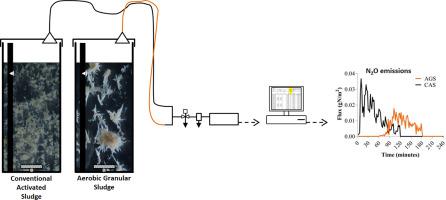Science of the Total Environment ( IF 8.2 ) Pub Date : 2020-11-21 , DOI: 10.1016/j.scitotenv.2020.143653 Benjamin J. Thwaites , Richard Stuetz , Michael Short , Petra Reeve , Juan-Pablo Alvarez-Gaitan , Nirmala Dinesh , Renae Philips , Ben van den Akker

|
Conventional activated sludge (CAS)-based wastewater treatment processes have the potential to emit high concentrations of nitrous oxide (N2O) during nitrification and denitrification, which can significantly impact the environmental performance and carbon footprint of wastewater treatment operations. While N2O emissions from CAS have been extensively studied, there is little knowledge of N2O emissions from aerobic granular sludge (AGS) which is now an increasingly popular secondary treatment alternative. The N2O emissions performance of AGS needs to be investigated to ensure that the positive benefits of AGS, such as increased capacity and stable nutrient removal, are not offset by higher emissions. This study quantified N2O emissions from a pilot-scale AGS reactor operated under a range of organic loading rates. A second CAS pilot plant was operated in parallel and under identical loading rates to allow for side-by-side comparison of N2O emissions from floc-based activated sludge. Under low loadings of <0.06 kg COD/m3/d the N2O emission factor from AGS and CAS were similar, at around 1.46 ± 0.1% g N2Oemitted/g ammonium loaded. A step increase in the organic loading rate increased N2O emissions from AGS more so than CAS which appeared to be attributed to the reactor feeding strategy that was required for AGS formation. The use of a separate anaerobic feeding phase which was followed by the aeration phase, resulted in extended periods of low dissolved oxygen (DO) concentrations combined with an initial high biomass ammonium loading rate, which favours N2O production and was exacerbated at higher organic loads. Conversely, the combined feeding plus aeration operation (aerobic feed) employed by the CAS system enabled a more even biomass ammonium loading rate and DO supply. This work has shown that while AGS has many operational benefits, the impacts that aeration profile, loading rate and feeding strategy have on N2O emissions must be considered.
中文翻译:

好氧颗粒污泥处理高盐城市污水中一氧化二氮排放的分析
常规的基于活性污泥(CAS)的废水处理工艺可能会在硝化和反硝化过程中释放出高浓度的一氧化二氮(N 2 O),这可能会严重影响废水处理操作的环境性能和碳足迹。尽管已经对CAS产生的N 2 O排放进行了广泛的研究,但对好氧颗粒污泥(AGS)产生的N 2 O排放却知之甚少,而好氧颗粒污泥现在已成为越来越受欢迎的二级处理方法。需要研究AGS的N 2 O排放性能,以确保AGS的积极益处(例如容量增加和养分稳定去除)不会被更高的排放所抵消。这项研究量化了N中试规模的AGS反应器在各种有机负荷速率下产生2 O排放。第二家CAS中试工厂在相同的负载率下并行运行,以便并排比较絮凝基活性污泥中的N 2 O排放。在<0.06 kg COD / m 3 / d的低负荷下,AGS和CAS的N 2 O排放因子相似,大约为1.46±0.1%g N 2 O排放/克铵。有机负荷率逐步增加,N 2增加AGS的O排放量比CAS多,这似乎归因于AGS形成所需的反应器进料策略。使用单独的厌氧进料阶段,然后进行曝气阶段,导致较低的溶解氧(DO)浓度延长时间,加上最初的高生物质铵负载率,这有利于N 2 O的产生,并且在较高的有机物含量下加剧负载。相反,CAS系统采用联合进料加曝气操作(好氧进料),可实现更高的生物量铵负载率和DO供应。这项工作表明,尽管AGS具有许多运行优势,但必须考虑曝气曲线,装载速率和进料策略对N 2 O排放的影响。











































 京公网安备 11010802027423号
京公网安备 11010802027423号